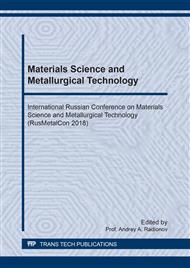p.678
p.684
p.690
p.696
p.702
p.709
p.719
p.726
p.732
Model for Solidification of the Working Layer of the Roll in the Chill of the Centrifugal Machine
Abstract:
The paper presents a mathematical model and the elements of a computer program for calculation and visualization of solidification of the rotating molten iron of the working layer of the roll in the centrifugal machine. We established the dynamics of changes in supply rate of carbide nanopowder feeding on the surface of the molten metal, provided its uniform distribution along the solidifying layer of the cast iron. It is shown that the working layer of the iron cools sideways and more intensively from the side of the chill mould; the areas, which are located near it, are the first to reach the solidus and liquidus temperatures. During cooling the layer of the iron, a maximum of temperatures is observed at a distance of 25 – 30 mm from the protective flux contacting surface. It was established that for a uniform distribution of nanopowder in the solidifying layer of the iron its feeding supply rate needs to be proportional to the speed of the moving the front of particle penetration, which is defined by the solidification front. Powder feeding needs to start from the time concurrent with the start of moving the front of particle penetration into the metal and to finish when an opposite crystallization front begins to form from the side of the flux.
Info:
Periodical:
Pages:
702-708
Citation:
Online since:
February 2019
Authors:
Keywords:
Price:
Сopyright:
© 2019 Trans Tech Publications Ltd. All Rights Reserved
Share:
Citation:


